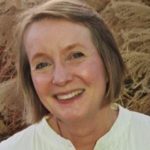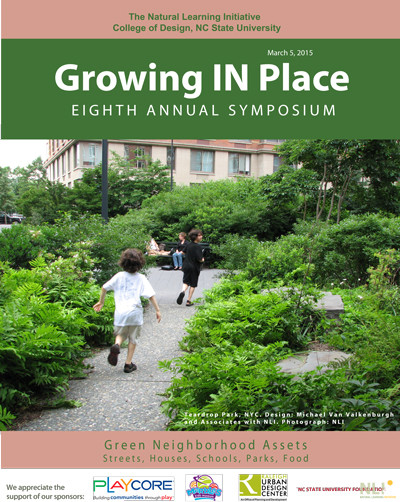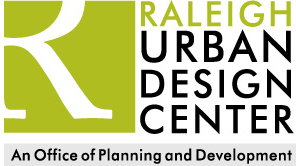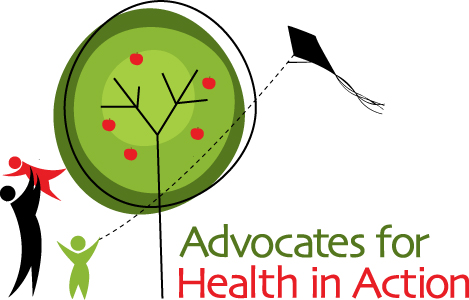Growing IN Place Symposium 2015
Green Neighborhood Assets: Streets, Houses, Schools, Parks, Food.
Families with children not wanting to move to low-density suburbs need neighborhoods and an urban public realm designed to support culturally diverse, socially stimulating, healthy lifestyles.
Program
Growing IN Place addresses planning and design policies that support these needs for children and other family members. Young people need networks of attractive, walkable/bikable routes connecting homes to schools, parks, community gardens, and cultural institutions – where they can engage with nature.
Growing IN Place is framed for an audience in North Carolina and adjacent states of public/private sector practitioners, including landscape architects, architects, and planners (receiving CEUs); parks and recreation professionals; nonformal educators, and elected officials.
Growing IN Place offers an annual focus on urban community/neighborhood design for health, sustainability, and wellbeing of children and families in the 21st century.
NC BOLA Course#: 10546; 6 credit hours.
Speakers
Presentations
 Jay Walljasper, Writer on urban planning, community development, and sustainability. Neighborhoods for All: The Design Imperative.
Jay Walljasper, Writer on urban planning, community development, and sustainability. Neighborhoods for All: The Design Imperative.
How can safe, sociable, walkable, bikeable, verdant urban neighborhoods be created that support the healthy development of children, families, and all people? Jay Walljasper will review examples of action around the world, where local community engagement demonstrates the imaginative possibilities of improving neighborhood livability through physical changes in the public domain.
 David Driskell, MCP. Executive Director of Community Planning, Housing, and Sustainability, City of Boulder, CO. Growing Up Boulder: Creating a Sustainable Partnership to Engage Young People in Community Design and Planning.
David Driskell, MCP. Executive Director of Community Planning, Housing, and Sustainability, City of Boulder, CO. Growing Up Boulder: Creating a Sustainable Partnership to Engage Young People in Community Design and Planning.
Boulder is a community with a strong culture of civic engagement, a proud history of vision-driven participatory planning, and an urban form that is compact, well connected, and surrounded by public open space. However, young people’s voices have often been absent in community decision making. Growing Up Boulder was formed as a partnership between the city, university, and school district, to engage young people — from preschoolers up to university undergraduates — in a wide array of planning and design initiatives, creating outcomes that better reflect young people’s needs and priorities and catalyzing a fundamental shift in perception for everyone involved.
 Robin Moore, Dipl.Arch, MCP, Hon. ASLA. Department of Landscape Architecture, NC State University; Director, Natural Learning Initiative. Designing Nature into City Childhood.
Robin Moore, Dipl.Arch, MCP, Hon. ASLA. Department of Landscape Architecture, NC State University; Director, Natural Learning Initiative. Designing Nature into City Childhood.
Publication of the National Guidelines, Nature Play and Learning Places (Moore, 2014), provides a practical, action framework for creating opportunities for children to engage with nature in the spaces of daily life (housing, street, park, school, childcare, community center, neighborhood, city). Such action requires pro-nature play and learning policies, inter-agency collaboration, and community support. Robin Moore will share case studies from North Carolina and beyond demonstrating a range of contexts, design opportunities, and organizational synergies to bring nature to the daily lives of children and families.
 Erin White, Founder, and Principal, Community Food Lab, Raleigh, NC. Urban Agriculture and Community Food Systems: The Role of Design.
Erin White, Founder, and Principal, Community Food Lab, Raleigh, NC. Urban Agriculture and Community Food Systems: The Role of Design.
Using Community Food Lab projects and additional case studies, Erin White will explain the role of design in creating diverse, healthy food systems. Effective design approaches are rare in food system development, despite the fact that designers are trained to solve complex problems such as those facing food systems today. From community gardens and urban farms to farmers markets and healthy food policy, well-designed food projects have the capacity to add value to local economies, support community health, and evolve into well-loved places. Healthy communities need healthy food. Design can help support both.
 Nancy Wells, PhD, Department of Design and Environmental Analysis, College of Human Ecology, Cornell University. School-grounds as Vehicles to Promote Health, Education, and Sustainability* (lecture video not given for online use)
Nancy Wells, PhD, Department of Design and Environmental Analysis, College of Human Ecology, Cornell University. School-grounds as Vehicles to Promote Health, Education, and Sustainability* (lecture video not given for online use)
A recent four-state study examines the effects of school gardens on children’s knowledge of nutrition/plant science and STEM self-efficacy. Nancy Wells will also describe a model urban school that integrates rooftop garden activities throughout their sustainability-based curriculum.
 Louise Chawla, PhD, Professor Emerita, Environmental Design Program, University of Colorado, Boulder, CO. Schoolgrounds as Places of Freedom, Engagement, and Tranquility.
Louise Chawla, PhD, Professor Emerita, Environmental Design Program, University of Colorado, Boulder, CO. Schoolgrounds as Places of Freedom, Engagement, and Tranquility.
Students can use naturalized school grounds for play, learning, and community service. Louise Chawla will share the results of three studies that examine how students value school grounds for these purposes, with a special focus on how they find release and restoration from stresses in other areas of their lives. Implications and principles for creating and managing successful, school-related outdoor spaces will be discussed.
 Jason Bocarro, PhD, Department of Parks, Recreation and Tourism Management, NC State University.
Jason Bocarro, PhD, Department of Parks, Recreation and Tourism Management, NC State University.
School-grounds as Community Places.
Across the U.S., tens of thousands of acres comprise school grounds, purchased and managed through local taxes to serve educational purposes. Lack of open space in many communities, especially in underserved neighborhoods, has motivated a movement to expand the role of school grounds as a community asset serving a broader set of needs beyond school. A growing number of successful examples of joint use exist on the ground. Jason Bocarro will share results of research conducted in Wake County Schools, NC, and discuss policy implications for designating school grounds as neighborhood and community parks, including issues of physical quality and joint management.
Discussion Panel The Future of School-grounds as Local Community Assets
Anna Stein, JD, MPH. Legal Specialist, Chronic Disease and Injury Section – Division of Public Health, NC Department of Health and Human Services.
Betty Parker, Senior Director, Real Estate Services, WCPSS.
Sig Hutchinson, Wake County Commissioner.
Christine Hilt, FASLA, PLA, LEED AP. President CLH Design, P.A., Civil Engineers & Landscape Architects.
As financial resources diminish and the cost of land acquisition and development increase, community facility shared use partnerships have received growing attention. Opening public schools for joint use – by municipal agencies, community-based organizations, and the general public – can maximize public access to school buildings and grounds, improve the allocation of scarce public resources (especially recreational space), increase physical activity among community residents, and if well-managed, generate revenue for school districts (at least to cover management costs).
Despite significant potential benefits, establishing joint/shared use partnerships has been difficult to achieve in many communities. School districts may lack stable or transparent guidelines for use and access while community-based organizations and other government agencies may not understand the full costs of such arrangements. Overcoming these barriers requires leadership and education to facilitate better understanding on both sides of the partnership, as well as significant thought, effort, and cooperation to reach agreement on a range of logistical issues, including liability insurance, additional maintenance/security costs, and hours of access.
Against this background, the panel will share successful models and discuss strategic arguments for implementing programs and physical improvements to capture the asset value of school grounds.





